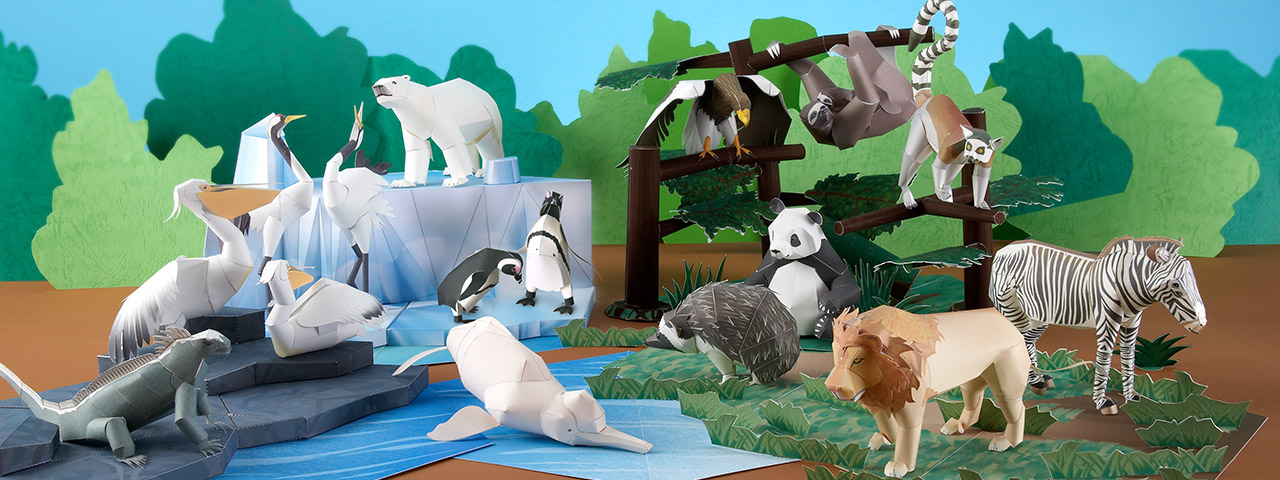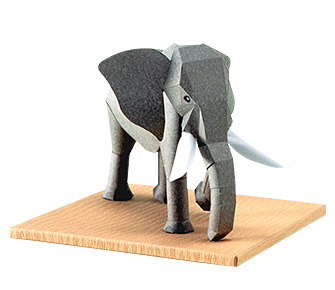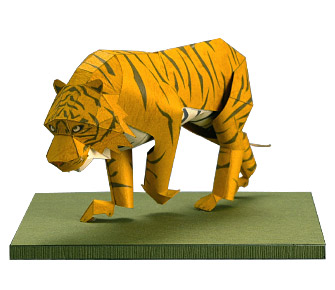African Elephant
Papercraft kit : The African elephant, the largest living land mammal.

An animal with a giant body, a long trunk, tusks and big ears. Surely everyone has seen an African elephant in the zoo. Yet, this seemingly familiar species has been decreasing in number in the wild. The African elephant is actually classified as an “Vulnerable[VU]” in the Red List.
Yamaha has added a new paper sculpture to the Rare Animals collection: the world's largest living land mammal, the African elephant. Assembly instructions for the paper sculpture of the African elephant, as well as a photo image of a completed sculpture, may be downloaded from this website.
Download - Parts sheet & InstructionsThis data was released in April, 2000.
African Elephant - Animal Guide

- African Elephant - Elephantidae
- Loxodonta africana
- 6 - 7.5 m (20 - 25 ft.) long (including trunk) / 3 - 4 m (10 - 13 ft.) tall
- 2016 Edition of the RED LIST categories : Vulnerable [VU]
The elephant, the largest living land mammal, is categorized mainly into two extant species: the Indian elephant and the African elephant. The latter has gray-brown skin and is generally larger in size than the former, reaching 6 meters or more (20 feet or more) in length and approximately 7 tons (15,400 pounds) in weight. The African elephant can be quickly distinguished from the Indian elephant not only by its greater size but also by its larger ears, which are frequently fanned in order to lower its body temperature. The species is also characterized by its long tusks, reaching 2 meters (80 inches) in length in both males and females.
The trunk, the most distinctive feature of elephants, is actually a greatly elongated upper lip and nose. This extremely versatile organ is able to grip and carry food to the mouth like human hands and draw water like a pump. It is also used to communicate within the herd.
In order to maintain its immensely large body, each elephant must consume as much as 150kg (330 lb) of bark, foliage and grass, and drink as much as 70 liters or more (approximately 18.5 gallons or more) of water a day.
The African elephant is matriarchal and associates in herds numbering in a few to dozens of family members led by an aged female. Bulls are driven from the herd and begin to live alone after some time. On the contrary, females stay with the mother within the herd.
Habitat
The African elephant inhabits the African continent, from which of course it derives its name. It is mainly found in tropical forests, savannas, marshes, semi-arid regions, river valleys, and highland regions south of the Sahara Desert reaching elevations of 5,000 meters or more (16,700 feet or more) above sea level. Due to its enormous diet, the animal is easily affected by environmental changes enforced by man, such as land development and environmental pollution. The number of African elephants has dropped enormously. This is ultimately the result of ivory hunting. It is said that at the beginning of the 20th century there were 10 million African elephants, but now there are less than 500,000 and the number continues to decrease.

About Red List
The Red List is the material prepared by IUCN (International Union for Conservation of Nature) classifying various threatened wild animals of the world and reporting their present habitat status.
The List evaluates the extinction risk level of each individual species from a biological viewpoint, but it possesses no legal power to enforce regulations concerning threatened species. The Red List is broadly employed as fundamental information in advancing the preservation of threatened wild animals.
Referring to the original Red List, the Environment Agency of Japan has compiled the Japanese edition of the List listing threatened taxa inhabiting Japan.
| Extinct | EX | No known individuals remaining. |
|---|---|---|
| Extinct in the Wild | EW | Known only to survive in captivity, or as a naturalized population outside its historic range. |
| Critically Endangered | CR | Extremely high risk of extinction in the wild. |
| Endangered | EN | High risk of extinction in the wild. |
| Vulnerable | VU | High risk of endangerment in the wild. |
| Near Threatened | NT | Likely to become endangered in the near future. |
| Least Concern | LC | Lowest risk. Does not qualify for a more at-risk category. Widespread and abundant taxa are included in this category. |
| Data Deficient | DD | Not enough data to make an assessment of its risk of extinction. |










